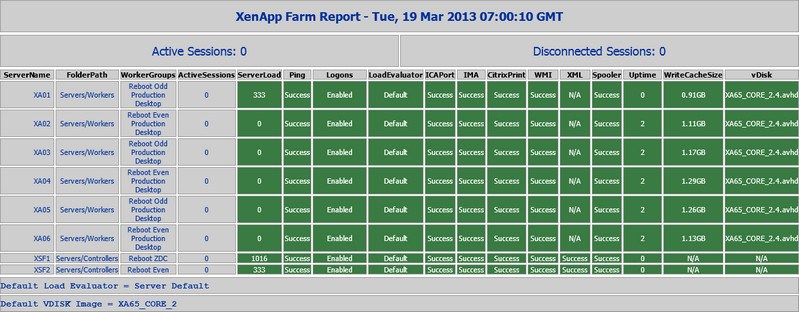

How to stop the Outlook 2010 first launch after pr.How to roam Outlook 2010 signature creation and as.

Customizing Microsoft Office 2010 with Microsoft O.How does Citrix XenDesktop 5.5 Power Management fo.Citrix XenDesktop 5.5 virtual desktops’ Citrix Rec.
 Configuring Citrix XenDesktop 5.5 virtual desktops. I’ll append to this post another day with more modifying cmdlets. **Note that the above command will overwrite the permissions currently set for the applications. Get-XAApplication -folderpath applications\Published\"Web Browsers" | Set-XAApplication -Account Set access rights for Group1 and Group2 to all of the applications in a folder named “Web Browsers” that’s located in another folder named “Published”: Get-XAApplication -FolderPath Applications\Published\"Clinical Apps" | Set-XAApplication -ClientFolder "Clinical Apps" Set the “Client Application Folder” properties field for all of the applications in a folder named “Clinical Apps” under the folder “Published” to “Clinical Apps”: Get-XAApplication -FolderPath Applications\"Office 2010 SP1" | Set-XAApplication -ServerNames, Set all of the applications in a folder named “Office 2010 SP1” to be published on multiple servers: Please replace with the name of the server you want to use to publish the applications. **Note that the above command will overwrite the servers that the application is published in with the server you specify. Get-XAApplication -FolderPath Applications\"Office 2010 SP1" | Set-XAApplication -ServerNames Set all of the applications in a folder named “Office 2010 SP1” to be published on a (one) server: Get-XAApplication -FolderPath Applications\"Office 2010 SP1" | Format-table DisplayName List the “DisplayName” attribute’s value of applications in a folder named “Office 2010 SP1”: Get-XAApplication -BrowserName Microsoft* | Format-Table DisplayName, CommandLineExecutable List applications that start with “Microsoft” and its specific attributes: … which outputs information similar to the following: … and if you want to use other variables, you can review the attributes available via the **Note that Enabled is the checkbox here:Īlternatively, you can use another variable such as HideWhenDisabled: Get-XAApplication -BrowserName Microsoft* | where-object | Format-Table DisplayName List applications with a variable equal to a value you specify: Get-XAApplication -BrowserName Microsoft* Get-XAApplication -BrowserName "Microsoft Word 2010" List applications based on BrowserName with a wild card: List a specific application based on BrowserName variable: Get-XAApplication > C:\XenAppApplications.txt
Configuring Citrix XenDesktop 5.5 virtual desktops. I’ll append to this post another day with more modifying cmdlets. **Note that the above command will overwrite the permissions currently set for the applications. Get-XAApplication -folderpath applications\Published\"Web Browsers" | Set-XAApplication -Account Set access rights for Group1 and Group2 to all of the applications in a folder named “Web Browsers” that’s located in another folder named “Published”: Get-XAApplication -FolderPath Applications\Published\"Clinical Apps" | Set-XAApplication -ClientFolder "Clinical Apps" Set the “Client Application Folder” properties field for all of the applications in a folder named “Clinical Apps” under the folder “Published” to “Clinical Apps”: Get-XAApplication -FolderPath Applications\"Office 2010 SP1" | Set-XAApplication -ServerNames, Set all of the applications in a folder named “Office 2010 SP1” to be published on multiple servers: Please replace with the name of the server you want to use to publish the applications. **Note that the above command will overwrite the servers that the application is published in with the server you specify. Get-XAApplication -FolderPath Applications\"Office 2010 SP1" | Set-XAApplication -ServerNames Set all of the applications in a folder named “Office 2010 SP1” to be published on a (one) server: Get-XAApplication -FolderPath Applications\"Office 2010 SP1" | Format-table DisplayName List the “DisplayName” attribute’s value of applications in a folder named “Office 2010 SP1”: Get-XAApplication -BrowserName Microsoft* | Format-Table DisplayName, CommandLineExecutable List applications that start with “Microsoft” and its specific attributes: … which outputs information similar to the following: … and if you want to use other variables, you can review the attributes available via the **Note that Enabled is the checkbox here:Īlternatively, you can use another variable such as HideWhenDisabled: Get-XAApplication -BrowserName Microsoft* | where-object | Format-Table DisplayName List applications with a variable equal to a value you specify: Get-XAApplication -BrowserName Microsoft* Get-XAApplication -BrowserName "Microsoft Word 2010" List applications based on BrowserName with a wild card: List a specific application based on BrowserName variable: Get-XAApplication > C:\XenAppApplications.txt 
The following are just some of my Citrix PowerShell notes that I’ll continue to build towards as I develop my toolkit for Citrix XenApp. Now moving onwards to Citrix, it’s great that they have adopted PowerShell but I find that it still needs a few iterations before it’s as powerful as what PowerShell does for Exchange. There really isn’t a whole lot you can’t do with the cmdlets and while most administrators including myself probably only use 5% (if even) what it’s capable of, I know if I needed to automate a task that the GUI doesn’t allow you to, PowerShell will be able to do so. Having worked with Microsoft Exchange 2000, 2003, 2007 and finally 2010, I’ve come to appreciate what Microsoft has done and how mature Exchange 2010 PowerShell cmdlets are today.








 0 kommentar(er)
0 kommentar(er)
